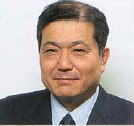(Chemical Engineering)

(Chemical Engineering)

(b. 1954), B.S.(1976, Waseda), M.Engr. (1978, Waseda), Ebara Infilco
Co. Ltd. and Ebara Research Co. Ltd. (1978-1989), Ph.D.(1988 Waseda), Assoc.
Prof. (1989 Waseda), Prof.(1995 Waseda).
Committee Member in Central Council of Environmental Protection (1995-1996),
Vice Chair of ISO14000 Confirmation Comittee (1996- ), Head of the Third
Planning Commitee, The Soc. Chem. Engr. Japan (1998- ).
The Award of Society of Sewage Japan (1982).
keywords
Industrial Crystallization / Environmental Chemical Engineering / Recycle Wastewater Treatment / Fine Particle Processing / Agglomeration and Granulation Engineering
Room 65-203A
3-4-1 Okubo, Shinjuku-ku, Tokyo 169-8555, Japan
Tel: +81-3-5286-3215
Fax: +81-3-3208-6896
E-mail:izumih@waseda.jp
URL: http://www.sci.waseda.ac.jp/research/ohxz.html
Research Interests
Chemical Engineering in the 21st century will contribute to the efficient and green manufacturing of valuable products. Industrial crystallization could support to produce such valuable and green products. Industrial crystallization research covers finding fundamental crystallization phenomena (nucleation, crystal growth, attachment of fines, agglomeration and transformation), design of crystallizer and its operation conditions, and establishment of crystallization process. Understanding these concepts would create the original research philosophy. As for research on the crystallization process, research projects on basic crystallization engineering, nano size crystals, pharmaceuticals and environmental/ recycling have been proceeded, focusing on the basic crystallization phenomena, such as nucleation, crystal growth and transformation rate. By these projects, desirable crystals of nano size distribution, crystallinity, mono dispersion and polymorph could be obtained selectively.
(1) Environmental/ Recycling project
In the niche between environmental chemical engineering and crystallization engineering, the new process has been developed to remove and recover substances from waste stream. Establishment of the optimum process and its operational conditions has been focused, to remove and recover ammonium, phosphate, fluoride and metal ion as a form of sparingly soluble crystals. In the process of reaction crystallization, fine crystals happens to be produced, but operational conditions to obtain crystals of desirable quality are investigated by considering method of supersaturation formation, attachment of fines and agglomeration. And also research on recovery of nickel metal from used bath of electroless nickel plating has been proceeded. This metal recovery method by using reduction crystallization would contribute to creation of nano size metals.
2) Nano Crystal Project
Study on quality design of fine crystals has been focused on crystallinity, purity and crystal size distribution. Fine crystals are produced by reaction crystallization and dilution crystallization of sparlingly soluble and soluble salts. The optimum operational conditions to obtain nano size crystals are investigated, to look into the basic crystallization phenomena and find out the model in the crystallizer. For example, interaction between polyelectrolyte and produced crystals, heterogeneous nucleation and nucleantion induced by ultrasonic wave are discussed.
(3) Pharmaceuticals/ Organic Crystal Project
Many pharmaceuticals have hydrophobic property, and so it is difficult to be taken in the human body. There is a need to obtain desirable crystals of soluble polymorph and nano size crystals. Reasearch on pharmaceutical crystallization has been investigated on the concept of crystallization engineering.
(4) Fundamental Crystallization Project
Dilution crystallization of NaCl have been investigated in the process of organic solvent addition. Development of heat storage using latent heat of crystallization had also been established, considering primary nucleation phenomena.
Representative Publications
1) Polymorphic Change of Calcium Carbonate during Reaction Crystallization in a Batch Reactor, Ind. Eng. Chem. Res., 43, 2650-2657 (2004)
2) Influence of Polyethlenimne on the Precipitation Process of lead Sulfate, Journal of Crystal Growth 260, 500-506 (2004)
3) "Crystallization phenomena of magnesium ammonium phosphate (MAP)
in a fluidised-bed -type crystallizer", Journal of Crystal Growth
237-239,2183-2187(2002)
4) "nm Size Control of Calcite From Amorphous State Triggered By Heterogeneous Substance", Chemical Engineering Transactions, Volume 1, 179-184 (2002)
5) "Prediction of Lysozyme Separation by Polyelectrolyte Precipitation
in Mechanically Agitated MSMPR Reactor", Journal of Chemical Engineering
Japan, Vol.34, 1259-1266 (2001)
6) "Effects of Experimental Conditions on the Mechanism of Particle
Aggregation in Protein Precipitation", Chemical Engineering Science,
56, 6525-6534(2001)
7) "Removal and Recovery of Nickel Ion from Wastewater of Electroless Plating by Reduction Crystallization", Korean Institute of Chemical Engineering Journal, Vol. 17. 629-632( 2000)
Back to: